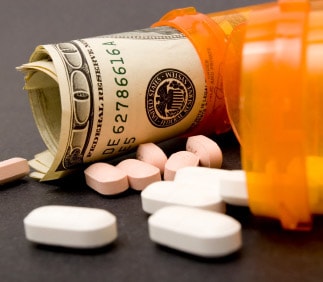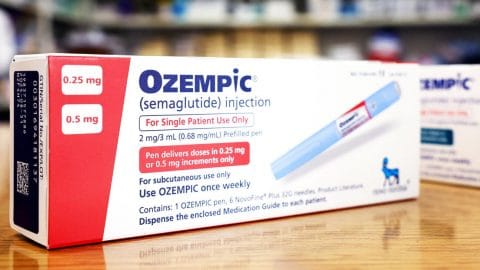IGF-1 (insulin-like growth factor-1) is a peptide hormone, produced predominantly by the liver in response to pituitary GH (growth hormone).[1] IGF-1 is involved in a wide variety of physiological processes. In adults, IGF-1 has metabolic and anabolic effects, and it mediates many of the effects of GH.[2-4]
GH and IGF-1 levels are reduced with normal aging, a phenomenon called somatopause.[5-7] It has been suggested that somatopause is an age-related GH deficiency state.[5] Somatopause has been considered to contribute to physiological deterioration seen with aging, like reduced muscle mass, reduced exercise tolerance, decreased strength, osteoporosis, increased fat mass, elevated cardiovascular risk, impaired quality of life, cognitive/memory decline and reduced immunity.[7-12] These changes are similar to those seen in classic (non-aging related) GH deficiency (GHD).[13, 14]
Consequences of high and low levels of GH and IGF-1
It is well-documented that abnormally high levels of IGF-1, seen in acromegaly, are associated with higher mortality and a higher prevalence of cancer and cardiovascular disease.[15] And vice versa, in hypopituitarism, abnormally low levels of IGF-1 have been implicated to be responsible for high all-cause and cardiovascular mortality.[16]
Associations of IGF-1 level within the normal range with disease are less clear. IGF-I has been suggested to promote atherosclerosis. Low-normal IGF-1 levels have been shown to be associated with development of heart disease and stroke [17-20] and higher circulating IGF-1 bioactivity is better associated with overall survival.[21] Men in the lowest IGF-1 bioactivity had an almost 2-fold increased mortality risk compared with men with the highest IGF-1 bioactivity.[21] In contrast, high-normal levels of IGF-1 have been reported to be associated with an increased risk of cancer.[22-27]
In humans, data on IGF-1 levels and longevity are conflicting.[28, 29] Decreased [30, 31] as well as increased [32] levels have been shown to be associated with reduced life expectancy in humans.
U-shaped relationship between IGF-I and mortality
If low IGF-1 levels are associated with an increased risk of developing cardiovascular disease and high IGF-1 levels are associated with an increased risk of developing cancer, there might be an optimal set point for the GH/IGF-1 axis associated with increased longevity. In line with this, several studies suggest an U-shaped relationship between IGF-I and mortality.[32, 33]
A notable study investigated the relationship between IGF-1 levels and all-cause/cause-specific mortality, cardiovascular disease and cancer, in a national representative sample of community-dwelling older persons over 65 years of age.[34] After a follow-up of 11.6 years and after adjustments for confounders (age, sex, BMI, smoking, alcohol use, diabetes, physical activity, and albumin), the results demonstrated a 28% increased risk of all-cause mortality with IGF-1 values in the lowest quintile (7.3 nmol/L) as compared to the middle quintile (13.5 nmol/L). The risk of all-cause mortality for persons with IGF-1 levels in the highest quintile (21.4 nmol/L) was increased by 17%. A more than 2-fold increased risk of cardiovascular mortality was found for both low-normal (239% increased risk) and high-normal (203 % increased risk) IGF-1 levels. This study found no significant associations were found between IGF-1 levels and nonfatal cardiovascular disease and fatal and nonfatal cancer.[34]
Summary
The decline of GH and IGF-1 levels with aging, aka somatopause, contributes to physical deterioration and increases mortality risk. It is interesting that having low-normal IGF-1 levels impose a greater risk of all-cause mortality and cardiovascular mortality than having high-normal IGF-1 levels. However, too high levels have been associated with cancer risk, which is important to bear in mind when undergoing GH (or IGF-1) therapy.
Because there is a U-shaped relationship between IGF-I level and mortality, if you are eligible for and consider GH therapy, it is advisable to aim for IGF-1 levels in the mid-normal range.
References:
1. Ohlsson, C., et al., The role of liver-derived insulin-like growth factor-I. Endocr Rev, 2009. 30(5): p. 494-535.
2. Baumann, G.P., Growth hormone doping in sports: a critical review of use and detection strategies. Endocr Rev, 2012. 33(2): p. 155-86.
3. Le Roith, D., et al., The somatomedin hypothesis: 2001. Endocr Rev, 2001. 22(1): p. 53-74.
4. Kaplan, S.A. and P. Cohen, The somatomedin hypothesis 2007: 50 years later. J Clin Endocrinol Metab, 2007. 92(12): p. 4529-35.
5. Martin, F.C., A.L. Yeo, and P.H. Sonksen, Growth hormone secretion in the elderly: ageing and the somatopause. Baillieres Clin Endocrinol Metab, 1997. 11(2): p. 223-50.
6. Lamberts, S.W., A.W. van den Beld, and A.J. van der Lely, The endocrinology of aging. Science, 1997. 278(5337): p. 419-24.
7. Di Somma, C., et al., Somatopause: state of the art. Minerva Endocrinol, 2011. 36(3): p. 243-55.
8. Maggio, M., et al., The hormonal pathway to cognitive impairment in older men. J Nutr Health Aging, 2012. 16(1): p. 40-54.
9. Deijen, J.B., L.I. Arwert, and M.L. Drent, The GH/IGF-I Axis and Cognitive Changes across a 4-Year Period in Healthy Adults. ISRN Endocrinol, 2011. 2011: p. 249421.
10. Angelini, A., et al., Insulin-like growth factor-1 (IGF-1): relation with cognitive functioning and neuroimaging marker of brain damage in a sample of hypertensive elderly subjects. Arch Gerontol Geriatr, 2009. 49 Suppl 1: p. 5-12.
11. Perrini, S., et al., The GH/IGF1 axis and signaling pathways in the muscle and bone: mechanisms underlying age-related skeletal muscle wasting and osteoporosis. J Endocrinol, 2010. 205(3): p. 201-10.
12. O’Connor, J.C., et al., Regulation of IGF-I function by proinflammatory cytokines: at the interface of immunology and endocrinology. Cell Immunol, 2008. 252(1-2): p. 91-110.
13. Woodhouse, L.J., et al., The influence of growth hormone status on physical impairments, functional limitations, and health-related quality of life in adults. Endocr Rev, 2006. 27(3): p. 287-317.
14. Thomas, J.D. and J.P. Monson, Adult GH deficiency throughout lifetime. Eur J Endocrinol, 2009. 161 Suppl 1: p. S97-S106.
15. Scacchi, M. and F. Cavagnini, Acromegaly. Pituitary, 2006. 9(4): p. 297-303.
16. Rosen, T. and B.A. Bengtsson, Premature mortality due to cardiovascular disease in hypopituitarism. Lancet, 1990. 336(8710): p. 285-8.
17. Janssen, J.A., et al., Serum total IGF-I, free IGF-I, and IGFB-1 levels in an elderly population: relation to cardiovascular risk factors and disease. Arterioscler Thromb Vasc Biol, 1998. 18(2): p. 277-82.
18. Johnsen, S.P., et al., Insulin-like growth factor (IGF) I, -II, and IGF binding protein-3 and risk of ischemic stroke. J Clin Endocrinol Metab, 2005. 90(11): p. 5937-41.
19. Juul, A., et al., Low serum insulin-like growth factor I is associated with increased risk of ischemic heart disease: a population-based case-control study. Circulation, 2002. 106(8): p. 939-44.
20. Dong, X., et al., The relationship between serum insulin-like growth factor I levels and ischemic stroke risk. PLoS One, 2014. 9(4): p. e94845.
21. Brugts, M.P., et al., Low circulating insulin-like growth factor I bioactivity in elderly men is associated with increased mortality. J Clin Endocrinol Metab, 2008. 93(7): p. 2515-22.
22. Renehan, A.G., et al., Insulin-like growth factor (IGF)-I, IGF binding protein-3, and cancer risk: systematic review and meta-regression analysis. Lancet, 2004. 363(9418): p. 1346-53.
23. Novosyadlyy, R. and D. Leroith, Insulin-like growth factors and insulin: at the crossroad between tumor development and longevity. J Gerontol A Biol Sci Med Sci, 2012. 67(6): p. 640-51.
24. Samani, A.A., et al., The role of the IGF system in cancer growth and metastasis: overview and recent insights. Endocr Rev, 2007. 28(1): p. 20-47.
25. Major, J.M., et al., Insulin-like growth factor-I and cancer mortality in older men. J Clin Endocrinol Metab, 2010. 95(3): p. 1054-9.
26. Furstenberger, G. and H.J. Senn, Insulin-like growth factors and cancer. Lancet Oncol, 2002. 3(5): p. 298-302.
27. Giovannucci, E., Insulin-like growth factor-I and binding protein-3 and risk of cancer. Horm Res, 1999. 51 Suppl 3: p. 34-41.
28. van Heemst, D., Insulin, IGF-1 and longevity. Aging Dis, 2010. 1(2): p. 147-57.
29. Sonntag, W.E., et al., Diverse roles of growth hormone and insulin-like growth factor-1 in mammalian aging: progress and controversies. J Gerontol A Biol Sci Med Sci, 2012. 67(6): p. 587-98.
30. Friedrich, N., et al., Mortality and serum insulin-like growth factor (IGF)-I and IGF binding protein 3 concentrations. J Clin Endocrinol Metab, 2009. 94(5): p. 1732-9.
31. Ruiz-Torres, A. and M. Soares de Melo Kirzner, Ageing and longevity are related to growth hormone/insulin-like growth factor-1 secretion. Gerontology, 2002. 48(6): p. 401-7.
32. Andreassen, M., et al., IGF1 as predictor of all cause mortality and cardiovascular disease in an elderly population. Eur J Endocrinol, 2009. 160(1): p. 25-31.
33. Janssen, J.A. and S.W. Lamberts, Igf-I and longevity. Horm Res, 2004. 62 Suppl 3: p. 104-9.
34. van Bunderen, C.C., et al., The association of serum insulin-like growth factor-I with mortality, cardiovascular disease, and cancer in the elderly: a population-based study. J Clin Endocrinol Metab, 2010. 95(10): p. 4616-24.







Thanks for the good info on GH and IGF-1. Sort of makes a guy wonder what to do. I’ll be 58 in a few months. What would be the mid range for me? I already get bi weekly shots of test cyp for low test levels. How do I find out what my IGF-1 count is and what it should be?
.
Tell you doctor you want to do a blood test for IGF-1.
Ideally you also want to check your IGFBP (binding proteins) IGFBP-3 and IGFBP-1.
This is another parameter most doctors are ignorant of and won’t check in the patient’s unless specifically requested. So you may have to put your foot down and insist on getting these labs!
Thanks Monica. Will do.
Hi Monica
What would be a safe and muscle building dose for a bodybuilder weighing 100kg with 8% body fat and the best way to cycle it?
Regards Jayson
When it comes to muscle growth and IGF-1, it is important to note that intra-muscular IGF-1 levels are more important for muscle growth that systemic (blood) levels of IGF-1.
And there is no clear-cut relationship between systemic and intra-muscular IGF-1. Testosterone seem to increase intra-muscular IGF-1 more that exogenous GH or IGF-1. As far as I know, no study has showed that supplementing with GH or IGF-1 increases intra-muscular IGF-1.
There is a great need for research to be taken on IGF-1 and the effects of it on mortality and its reference to cancer and other cardio vascular diseases.
Prolonged use of HGH Supplements may lead to Cardio vasular diseases and liver related. HGH effects the arteries.
There’s no legit HGH supplements and zero studies to show an increased risk of CVD or liver disease from using them.